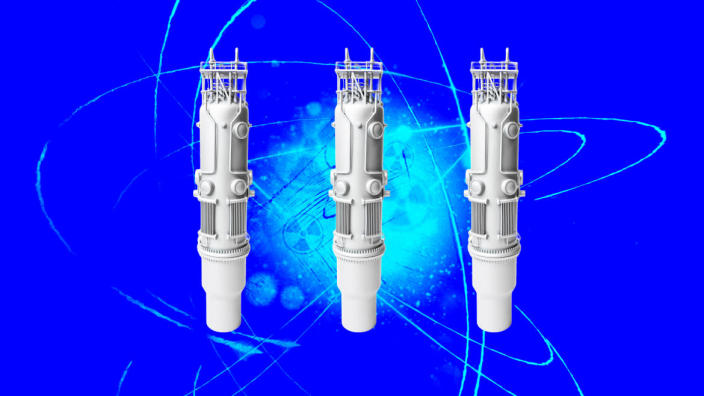[ad_1]

Toiling in a Pittsburgh suburb, a Nigerian-born engineer just may keep the crucial to decarbonization by applying an vitality source which is lengthy been maligned and misunderstood: nuclear electrical power.
Dr. Sola Talabi is an adjunct assistant professor of nuclear engineering at the University of Pittsburgh and a senior specialist at Pittsburgh Technological, an advisory firm that gives chance management solutions to the nuclear power industry. He’s an qualified in highly developed modest modular reactors (SMR), mini-nuclear vegetation ranging in dimensions from tens to hundreds of megawatts (MWe).
Like a substantial reactor, SMRs crank out electric power by nuclear fission. In their core, neutrons collide with gas atoms—usually uranium—splitting them aside. As the atoms split, they release much more neutrons, which split extra atoms in a sustained chain response, and vitality. The vitality is transferred to a circulating coolant, generally h2o, triggering its temperature to rise. The heated coolant then passes by means of a warmth exchanger, producing steam that drives an electrical turbine and making usable electrical power.
Talabi believes that SMRs present a practical, environmentally-friendly alternative to fossil fuels, capable to fulfill the world’s expanding electricity demands while slashing carbon emissions and air pollutants. “I consider nuclear energy has the means to resolve [the world’s two biggest problems:] worldwide power poverty and world-wide warming,” Talabi instructed The Every day Beast. “Nuclear can uniquely handle people issues.”

A modest modular reactor can take up a fraction of the region a classic nuclear electrical power plant does.
Courtesy of Idaho Countrywide Laboratory
Whilst novel in the civilian strength sector, SMRs have run naval warships and submarines for practically 70 years. U.S. naval nuclear reactors have logged much more than 5,400 reactor decades, and steamed more than 130 million miles with no a single radiological incident or radiation-similar fatality. This sterling security document lets the U.S. Navy to work its reactors largely without the need of controversy even in Japan, a country that has a potent anti-nuclear motion birthed by Hiroshima and Nagasaki, and amplified by Fukushima.
Irrespective of the accomplishment, SMRs—and nuclear power as a whole—have failed to capture on in the U.S. civilian vitality sector. In point, nuclear gives only about 20 per cent of the nation’s vitality, and all from getting old significant-scale reactors. Incidents these types of as 3 Mile Island, Chernobyl, and Fukushima have further eroded community help. Even if it could overcome the PR hurdles, the industry still faces different fiscal and supply chain problems. Even so, Dr. Talabi insists that all these issues can be solved or minimized by simply just scaling down.
For starters, he asserts that SMRs are much safer than massive-scale reactors. The worst-case scenarios for standard nuclear crops are reduction of coolant or decline of movement mishaps in which a plant loses its capability to get rid of heat generated by the fuel, and the core melts down. At Three Mile Island, this happened owing to a stuck open up relief valve in the plant’s pressurizing system. At Fukushima, it was owing to a decline of electrical ability to the plant’s reactor coolant pumps.
On the other hand, SMRs take advantage of cutting-edge structure to eradicate the chance of these types of mishaps. Circulation by the core is attained working with thermal convection (hot drinking water rises, cold drinking water sinks), so the plant can clear away heat produced by its gasoline even if electrical electricity is shed. Up coming-technology SMRs are also intended this kind of that they do not require a pressurizing program like the one particular that failed at 3 Mile Island.
How We Could possibly Eventually Get Over Our Concern of Nuclear Electricity
Even in the extraordinarily inconceivable party of a core meltdown, Talabi said that SMRs are even now remarkably harmless. As opposed to their substantial-scale predecessors, the diminutive sizing of SMRs eliminates the need to have for energetic safety systems backed by human operators. If radionuclide particles—an unstable factor which is unsafe to humans—are introduced from the core, gravity and other organic phenomena these kinds of as thermal and steam focus will power them to settle properly in just the confines of the plant’s containment vessel. In the nevertheless additional unlikely situation that radionuclide particles breach the containment vessel, Talabi’s study indicates they will settle around a considerably smaller sized space than if they have been produced from a substantial-scale reactor, posing considerably less of a overall health and environmental hazard and simplifying cleanup.
Security aside, one of the biggest fears critics have about SMRs is their value. A modern output price examine by the German authorities retains that about 3,000 SMRs will want to be produced to offset their first building prices. But Talabi claimed that estimates like the German government’s are lifeless mistaken. “It’s as though we’ve only at any time created tractor-trailers and we’re striving to figure out what the price of a motorbike is,” he spelled out.
Talabi statements that most economists basically acquire the output expense of a Westinghouse massive scale AP1000 reactor—a preferred nuclear energy plant design—and suppose the price tag of an SMR will be proportionally smaller. For illustration, they figure an SMR that creates 100 MWe of ability will charge 10 p.c as considerably as an AP1000 that produces 1000 MWe of power. However, the economists really do not comprehend that numerous of the units demanded by big-scale reactors, this kind of as the types that sustain tension and coolant movement in the plant’s main, will not be miniaturized in the more compact vegetation. They’ll be removed.
Inside of the Gas Industry’s System to Sink Nuclear Ability
SMRs should also be much less costly due to the fact they can be manufacturing facility-fabricated, and their smaller sized pieces will be less difficult for much more producers to produce. When only just one or two suppliers globally can generate a reactor vessel for an AP1000, lots of makers in the U.S. on your own should be capable to make a single for an SMR.
Even with his optimism for SMRs’ likely, Talabi acknowledges that they have some drawbacks. Prevalent use could slash carbon emissions, but will necessitate greater uranium mining. They also create a protection threat, as nuclear gasoline will want to be transported amongst hundreds of destinations, and reactor web sites may perhaps be specific by warring states and terrorists. Federal government statutes also fail to account for distinctions between SMRs and large-scale reactors, inhibiting their development. Acquiring nations around the world badly in need of electrical electric power absence the regulatory infrastructure to take the know-how. And their citizens—exposed to nuclear energy only as a result of bad information stories—might be even more durable to get above than People in america.
That claimed, Talabi thinks that SMRs’ possible in solving weather adjust and global electrical power poverty considerably outweighs their risks, and makes beating their road blocks effectively well worth it. To that end, he started Local climate Motion Through Nuclear Deployment in Building International locations (CANDiD). CANDiD hopes to use engineering to develop regulatory frameworks that building nations can benefit from to acknowledge and run SMRs. It also aims to greater familiarize the world populace with the workings and added benefits of nuclear vegetation.
“It’s not a technologies challenge,” Talabi reported. With community and govt help, SMRs could shortly be powering the world with carbon-absolutely free electrical power. To Talabi, it’s just a make a difference of awareness and being familiar with.
Read extra at The Each day Beast.
Keep educated and obtain limitless access to the Daily Beast’s unmatched reporting. Subscribe now.
[ad_2]
Resource link









More Stories
5 Ways to Boost Data Security on the Cloud
Apple Black Friday Sales, iPhone 15 Pro rumors, Device Buying Guide
How Businesses Can Overcome Cybersecurity Challenges